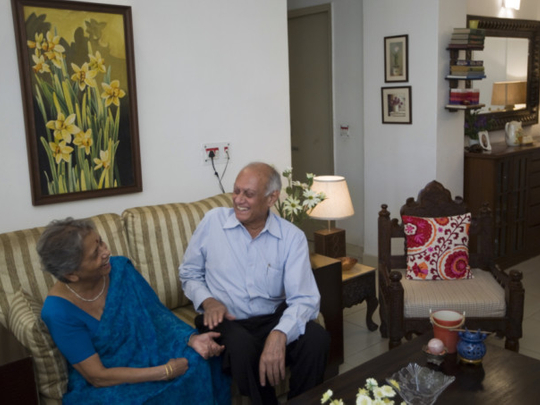
With a rise in life expectancy and household wealth in India, an increasing number of well-heeled senior citizens have now started to invest in plush retirement communities that take care of their lifestyle, security, entertainment and health-care requirements.
Sensing demand for such projects among affluent resident and non-resident Indians (NRIs), developers are now building senior living complexes all over India. Though the sector is still in its nascent stage, experts say it has the potential to transition from niche to mainstream.
Sheer numbers drive growth
According to Jones Lang LaSalle (JLL) India, a financial and professional services firm specialising in real estate services, the percentage of elders as a percentage of total population in the country is projected to jump from 7.4 per cent in 2001 to 12.4 per cent in 2026 and touch 19.7 per cent in 2050. While India was home to about 76 million seniors above the age of 60 years in 2011, it is expected that this figure will grow to 173 million by 2025, further increasing to about 240 million by 2050.
B. Sridhar, Senior Consultant — Strategic Consulting (education, health care and senior living), JLL India, says, “Given the country’s demographic profile, the demand for senior living projects is certainly expected to grow significantly over the next five to ten years. More real estate developers will explore this segment as part of their larger integrated township developments.” Though senior living projects were concentrated in tier-II and tier-III cities, they are catching on in metropolitan cities as well. >
However, a lot will depend on the acceptance of the key projects that have already been launched in the market, as and when they are delivered, Sridhar adds.
The senior living or independent living (IL) segment deals with the age bracket of 50+ years, wherein active adults are able to take care of themselves and generally do not have serious health issues. Assisted living (AL), on the other hand, caters to adults aged 65 and above, who need assistance with daily activities, but do not require nursing home care. “IL will see greater market movement and supply. The market is yet to mature for services offered in the AL, skilled nursing and continuing care retirement communities segments,” says Sridhar.
With the breakdown of the traditional concept of multigenerational joint families, coupled with an increase in disposable incomes, senior citizens in India are gradually warming up to the concept of retirement homes.
Talking to Brotin Banerjee, MD and CEO of Tata Housing, we get an insight into the direction the market is set to take.
“Seniors are now evolving as a customer segment and they have their needs and wants, which are different from seniors in earlier times,” he says.
“Lifestyle solutions for seniors are presently almost non-existent in India. Our pre-entry research suggested that a significant section of seniors today are independent, financially stable, well-travelled and socially connected. As a result, [they] have well-developed plans about their life after retirement,” Banerjee states, adding, “There is a huge potential in this segment. Research says that the demand for senior homes is more than three hundred thousand units in urban centres, while only 3,000 units are currently available in the market.”
What do seniors exactly want?
Perceptions of ageing and retirement homes have changed over the years in India. A study conducted by market research firm, AZ Research highlights the changing needs of today’s elderly generation. Three out of every four seniors in India are now ready to move to an assisted senior living community. The report also suggests that 80 per cent seniors in India are concerned about break-ins and stealing, 70 per cent want to move out of town into a home of their own and 42 per cent rank security among the top three requirements from a living space. More than 80 per cent seniors seek to sustain or improve their lifestyles as they do not wish to retire and more than 75 per cent seniors want to socialise, club, party, exercise, play sports and shop for luxury goods.
With nearly 100 million seniors in India, it is no surprise that the segment offers strong growth prospects for buyers as well as developers. Tata Housing is among a growing number of companies tapping into the emerging senior living sector along with Antara Senior Living, LIC Housing Finance Ltd, and Ashiana Housing Ltd. Tata Housing forayed into the senior living space with Riva Residences in Bengaluru, offering amenities that range from a convenience store, health-care centre, parks, meditation centres and spa to reading rooms, a temple, amphitheatre, professional housekeeping and gardening services.
Tata Housing has plans to invest around 12 billion rupees (about Dh730 million) into the segment and cover the top eight cities in India by 2018. “The newly launched projects would be a part of Tata Housing’s current > townships in and around Ahmedabad, Mumbai, Kolkata, Chennai and the National Capital Region among other locations,” Banerjee says.
What’s trending?
When it comes to senior living properties, though customers are now showing greater preference for the complete sale model, the demand for short and long-term rentals and lease models are also gaining traction.
Antara Senior Living, which is part of Max India, offers a lifetime lease model to customers. Tara Singh Vachani, CEO, Antara Senior Living, says, “After the payment of the initial amount, though, the rights of the usage of an apartment lies with the resident, the management of the community is run by Antara. We generate revenues from the monthly maintenance charges.
“According to this model, it is our responsibility to maintain the community and offer our residents the best services,” Vachani says, adding, “Antara also helps re-lease the apartment if a resident has to leave the community for any reason. The appreciation value of the apartment during this re-lease will be given to the resident post deduction of administrative charges.”
Antara is developing its project in a 20-acre area in the north Indian city of Dehradun with a view of the Mussoorie hills, and is designed to meet the unique needs of senior citizens. Comprising 217 apartments with sizes varying from 1,500 square feet to 7,000 square feet, units will come with prices ranging from 14 million rupees to 50 million rupees. The apartments will be ready to move in by early 2016.
The company has partnered with renowned international architects and consultants to design and develop its first community in Dehradun. Perkins Eastman from New York, which has a reputation for designing superior lifestyle communities around the needs of seniors, and Esteva & Esteva Arquitectura from Spain, which is known for its creative designs, are the principal architects for this community.
Ashiana Housing, a leading player in the senior housing sector with projects in Bhiwadi, Jaipur and Lavasa, offers one, two and three- bedroom apartments and villas with prices ranging from Rs2.5 million to Rs12 million.
Ankur Gupta, Joint Managing Director, Ashiana Housing, says, “While the typical buyers for such projects are the senior citizens and retirees, NRIs, who want their parents to live in a healthy environment amidst a good lifestyle, are also investing in our projects. 20-25 per cent of our clients are from abroad.”
To make it easier for seniors to invest in its projects, Tata Housing has exclusive finance tie-ups with Tata Capital, Axis Bank and Central Bank where the senior citizens can avail of easy loans on exclusive interest rates. The company has also extended loan eligibility to buyers up to 70 years.
“The development cost of a senior living project is 3-4 per cent higher than an ordinary residential project. The cost escalates because of the architectural designs where each home is built with amenities that cater to the needs of the senior citizens. Additional services and support facilities are also offered at an additional cost,” says Banerjee. n











